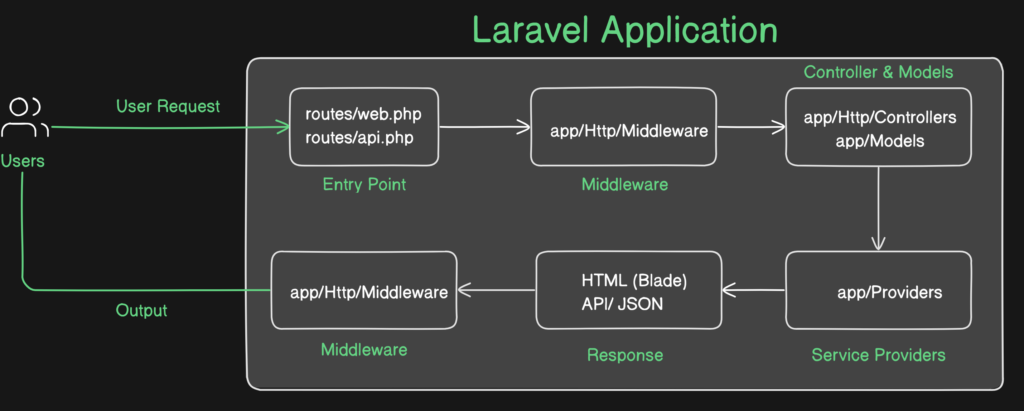What is Laravel Request Life Cycle? it is a process of this framework which defines how requests passes through different different stages and how it processes it self. And, finally, How we gets an output. We will look into it step by step, You can download PPT from the end of this blog post.
We can understand Laravel Request Life Cycle in two way. One is a simple way and one is pure technical way (In detail). We will cover both the way in this blog post.
Simple way

- Entry Point:
- The process starts when a user makes a request to your Laravel application. This request can be for a web page, an API endpoint, or some other resource.
- Routing:
- Laravel’s first task is to determine which route should handle the incoming request. Routes are defined in your
routes/web.phporroutes/api.phpfiles.
- Laravel’s first task is to determine which route should handle the incoming request. Routes are defined in your
- Middleware:
- Once the route is identified, the request passes through middleware. Middleware are classes that can perform actions before and after the actual request handling. They might handle tasks like authentication, logging, or modifying the request.
- Controller:
- After passing through middleware, the request reaches the controller. Controllers are responsible for processing the request and returning a response. They contain methods (functions) that handle specific actions.
- Service Providers:
- Service providers are classes that register services and bind them into the Laravel service container. These services could be anything from database connections to third-party libraries.
- Eloquent ORM (Optional):
- If your controller interacts with a database, Laravel’s Eloquent ORM comes into play. It allows you to interact with your database using a simple syntax and provides powerful features like model relationships.
- Response:
- After the controller has processed the request, it returns a response. This response could be an HTML page, JSON data for an API, a redirect, or any other type of valid HTTP response.
- Middleware Again:
- The response goes back through the middleware stack. This time, middleware might be used to modify the response or perform other tasks after the main processing is done.
- Termination:
- The final response is sent back to the user’s browser or the calling system. The Laravel request life cycle is complete.
Pure Technical Way
As mentioned in Laravel’s official documentation request passes through many internal elements one by one and validated. Let’s try to break it down and understand in simple words.
- Entry Point (
public/index.php):- The request enters the application through the
public/index.phpfile. - This file includes the Laravel bootstrap file (
bootstrap/app.php), which sets up the Laravel application.
- The request enters the application through the
- Kernel Initialization:
- The
App\Http\Kernelclass is instantiated. - The
handlemethod of the kernel is called, and it receives the incoming request.
- The
- Middleware Execution:
- Middleware components are executed in the order defined in the
$middlewareproperty of theApp\Http\Kernelclass. - Global middleware is applied to every HTTP request.
- Route middleware is applied based on the route definition.
- Middleware components are executed in the order defined in the
- Route Handling:
- The router matches the incoming request to the appropriate route defined in the
routes/web.phporroutes/api.phpfile. - If a route is matched, the associated controller method is executed.
- The router matches the incoming request to the appropriate route defined in the
- Controller Execution:
- The controller method is responsible for processing the request and returning a response.
- The controller may interact with models, services, and other components to perform the required actions.
- View Rendering (Optional):
- If the controller returns a view, Laravel renders the corresponding view file.
- The view may include dynamic data passed from the controller.
- Response Creation:
- The response is created and sent back to the user’s browser.



Leave a Reply